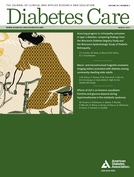Diabetes Care:LOGIC-Insulin算法指导强化血糖控制效果佳
2013-02-26 Diabetes Care 医学论坛网 范伟伟 编译
来自荷兰鲁汶大学的一项前瞻性、平行组、随机对照临床试验显示,应用计算机软件程序LOGIC-Insulin实施强化血糖控制(TGC)的效能优于经验丰富的护士,且不增加低血糖事件的发生率。该研究2013年2月在线发表在《糖尿病护理》杂志(Diabetes care)上。 对危重患者实施TGC较为困难,且工作强度大,导致血糖控制效果不佳和低血糖发生率增加。LOGIC-Insul
来自荷兰鲁汶大学的一项前瞻性、平行组、随机对照临床试验显示,应用计算机软件程序LOGIC-Insulin实施强化血糖控制(TGC)的效能优于经验丰富的护士,且不增加低血糖事件的发生率。该研究2013年2月在线发表在《糖尿病护理》杂志(Diabetes care)上。
对危重患者实施TGC较为困难,且工作强度大,导致血糖控制效果不佳和低血糖发生率增加。LOGIC-Insulin计算机软件程序已被开发用于协助糖尿病患者的护理,它通过滴定胰岛素以维持血糖水平在80〜110毫克/分升(正常血糖),避免严重低血糖(<40毫克/分升)的发生。该研究旨在评估临床应用LOGIC-Insulin相比较经验丰富护士实施TGC的有效性。
该研究前瞻性纳入300例异质的危重患者群,通过隐秘的电脑随机派位,分为护士指导的血糖控制组(Nurse-C)或算法指导的血糖控制组(LOGIC-C)。采用血糖处罚指数(GPI)作为有效性的测量结果,GPI即对偏离正常血糖水平的血糖升高和血糖降低的罚分测量指标;采用低血糖(<40毫克/分升)发生率作为安全性的测量结果。
结果表明,Nurse-C组151例患者和LOGIC-C组149例患者的基线特征和学习时间没有显著性差异。Nurse-C组的GPI为12.4(四分位范围8.2-18.5),而LOGIC-C组的GPI下降至9.8(四分位范围6.0–14.5)(P <0.0001)。学习时间在目标范围的比例在LOGIC-C组患者为68.6±16.7%,在Nurse-C组患者为60.1±18.8%的护士-C患者(P = 0.00016)。严重的低血糖事件的比例在LOGIC-C组显著下降(Nurse-C为0.13%,LOGIC-C为0%,P = 0.015);然而当考虑为患者比例时,LOGIC-C组未显著下降(Nurse-C为3.3%,LOGIC-C为0%,P = 0.060)。采样间隔时间在LOGIC-C组为2.2±0.4小时,Nurse-C组为2.5±0.5小时(P <0.0001)。

LOGIC-Insulin Algorithm–Guided Versus Nurse-Directed Blood Glucose Control During Critical Illness
The LOGIC-1 single-center, randomized, controlled clinical trial
OBJECTIVE
Tight blood glucose control (TGC) in critically ill patients is difficult and labor intensive, resulting in poor efficacy of glycemic control and increased hypoglycemia rate. The LOGIC-Insulin computerized algorithm has been developed to assist nurses in titrating insulin to maintain blood glucose levels at 80–110 mg/dL (normoglycemia) and to avoid severe hypoglycemia (<40 mg/dL). The objective was to validate clinically LOGIC-Insulin relative to TGC by experienced nurses.
RESEARCH DESIGN AND METHODS
The investigator-initiated LOGIC-1 study was a prospective, parallel-group, randomized, controlled clinical trial in a single tertiary referral center. A heterogeneous mix of 300 critically ill patients were randomized, by concealed computer allocation, to either nurse-directed glycemic control (Nurse-C) or algorithm-guided glycemic control (LOGIC-C). Glycemic penalty index (GPI), a measure that penalizes both hypoglycemic and hyperglycemic deviations from normoglycemia, was the efficacy outcome measure, and incidence of severe hypoglycemia (<40 mg/dL) was the safety outcome measure.
RESULTS
Baseline characteristics of 151 Nurse-C patients and 149 LOGIC-C patients and study times did not differ. The GPI decreased from 12.4 (interquartile range 8.2–18.5) in Nurse-C to 9.8 (6.0–14.5) in LOGIC-C (P < 0.0001). The proportion of study time in target range was 68.6 ± 16.7% for LOGIC-C patients versus 60.1 ± 18.8% for Nurse-C patients (P = 0.00016). The proportion of severe hypoglycemic events was decreased in the LOGIC-C group (Nurse-C 0.13%, LOGIC-C 0%; P = 0.015) but not when considered as a proportion of patients (Nurse-C 3.3%, LOGIC-C 0%; P = 0.060). Sampling interval was 2.2 ± 0.4 h in the LOGIC-C group versus 2.5 ± 0.5 h in the Nurse-C group (P < 0.0001).
CONCLUSIONS
Compared with expert nurses, LOGIC-Insulin improved efficacy of TGC without increasing rate of hypoglycemia.
本网站所有内容来源注明为“梅斯医学”或“MedSci原创”的文字、图片和音视频资料,版权均属于梅斯医学所有。非经授权,任何媒体、网站或个人不得转载,授权转载时须注明来源为“梅斯医学”。其它来源的文章系转载文章,或“梅斯号”自媒体发布的文章,仅系出于传递更多信息之目的,本站仅负责审核内容合规,其内容不代表本站立场,本站不负责内容的准确性和版权。如果存在侵权、或不希望被转载的媒体或个人可与我们联系,我们将立即进行删除处理。
在此留言








#DIA#
54
#Diabetes#
50
#BET#
40
#insulin#
48
#强化血糖控制#
46
#血糖控制#
41